
Ronan Kelly, Bard of Erin - The Life of Thomas Moore. Penguin, Dublin, 2008, ISBN 978-1-844-88143-7, 624pp, €32.
FolkWorld Issue 37 11/2008; Book Reviews by Walkin' T:-)M
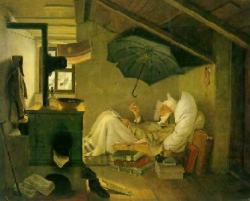
Singer and writer Ewan MacColl, one of the driving forces behind the 1950s folk music revival in Britain, is everywhere. Even twenty years after his death he is a 'pop star' in folk music circles. Well, talking about pop stars. In his days Liszt was one, so was Thomas Moore in 19th century Britain and Ireland. Let's learn something more about both Tom and Ewan in particular, and folk music and dancing in general.

Ronan Kelly, Bard of Erin - The Life of Thomas Moore. Penguin, Dublin, 2008, ISBN 978-1-844-88143-7, 624pp, €32. |
Recently, Irish Minister Martin Cullen said at the launch of the exhibition "My Gentle Harp" at the Royal Irish Academy in Dublin: It was the 'Irish Melodies' with their international fame that defined Irish culture throughout the nineteenth century at home and abroad. Just one or two generations before, as Ronan Kelly noticed, mothers doing housework would hum the lyrics, schoolboys would sing it for some inspecting Monsignor.
The Irish Melodies' author was poet, singer and composer Thomas Moore who was born on 28 May 1779 in 12 Aungier Street on Dublin's south side, the son of a Catholic grocer. Recitation was the first talent, he had Shakespeare with six years of age. Tom Moore taught himself the pianoforte and started composing poetry. He could not remember a time, he said, not scribbling his scraps of rhyme.
Tom began studies at Trinity College Dublin in 1795, his tutor being Reverend Robert Burrowes, the author of a flash song called "The Night Before Larry Was Stretched". One of his friends was Edward Hudson, an enthusiast of traditional Irish music, who was collecting and transcribing old airs to play on the flute. Hudson introduced Moore to Edward Bunting's "General Collection of the Ancient Irish Music," the mine from the working of which my humble labours as a poet have since acquired their sole lustre and value.
Another friend was Robert Emmet. In 1798 Emmet dropped out of Trinity and into the radical underground of the United Irishmen uprising. However, while politics agitated the city outside, Tom locked himself up to study the 6th century BC Greek poet Anacreon. He published a translation of his Baccanalian Odes of wine, women and song in 1800.
Emmet was the man of action, who died, having risen up, while Moore, the man of letters, lived - to talk and to write and to fit the myth to a melody for several generations to sing.
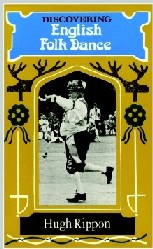
Tom Moore too used practising country dancing. There are two sorts of folk dancing in the English tradition, explains Hugh Rippon: social dancing and the ritual ceremonial dance. Of the latter there are three major forms: morris dance, sword dance and hobby-horse dance. The author, who has taught English folk dance around the world, tries to explain: Ritual dancing in England is as old as the first permanent settlers. For example, the rapper or short sword dances are all found in the old kingdom of Northumbria while the long sword dances are all found in the old kingdoms of York. The Cotswold morris dances are all found in the territories which were predominantly Saxon. The theory that morris dancing was brought to England by John of Gaunt's troops who had learnt it from the Moors now no longer holds water. He gives examples: Grenoside, South Yorkshire, four miles north of Sheffield, has a team of sword dancers who appear traditionally on Boxing Day morning, as part of the formerly more elaborate midwinter rituals. The six dancers carry swords about three feet long, and, linked together, perform various interweaving figures. The highlight of the dance is the decapitation of the captain, representing the ritual death of the leader of the community who in ancient times was sacrificed for the common good but who came back to life again. At Grenoside the captain is a seventh man wearing a rabbitskin cap with the animal's head to the front. At one point in the dance the captain stands inside the circle of six dancers, the swords are locked around his head and then drawn. The captain falls over and the cap is knocked off. On the other hand are social folk dances, as distinct from display purposes. Country dances, set dances with a particular programe of figures and perverted into contre danse by the French, were increasingly fashionable from the 17th century, until replaced by waltzes and polkas. Hugh Rippon's Discovering English Folk Dance first published in 1975, describes the history (the little that is known) and in detail today's relics or newly created dances. The booklet is richly b/w illustrated, and useful for to see traditional teams, to get involved into social folk dancing. So never again dare to say: well, we didn't know the English had so many dances of their own! Hugh Rippon, Discovering English Folk Dance. Shire Discovering, 1975 / 2008, ISBN 978-0-7478-0225-9, 96pp, £6,99. |
The first installment of the Irish Melodies appeared in 1808, a tall, slim booklet to sit atop the pianoforte. It featured twelve songs, such as "The Harp That Once" and "The Meeting of the Waters". Half of the airs were drawn from the Bunting collection. Ronan Kelly observed that Moore penned lyrics which spoke of love, of remembrance, of love of one’s country. Sometimes derided as drawing-room ballads, the Melodies had strong political undertones.
In the Melodies, the spirit of Erin is always oppressed, and always indomitable; it is the spirit of love, fidelity and friendship; it is right - ancient, moral, Irish - against might - modern, military and, if not exactly English, then at least its poetic equivalents, Saxon or Dane. To sing of Ireland was to stir up English anxieties, but Moore went even further: in the Melodies, Ireland was heroic, dignified, even - amazingly - respectable.Tom Moore was playing pioneering role in making Irish culture respectable to an English audience - an achievement that brought at first adulation and reverence and then a later generation's suspicion and rejection. Moore died on 25 February 1852, and here the narrative of Bard of Erin stops, being an account of Tom Moore's life, not of his reception and appreciation. Ronan Kelly says:
By fighting shy of the famous Melodies, my research uncovered a much more complex figure than the faint sentimentalist admired by Joyce and disliked by Yeats. The Moore I discovered was a gifted scholar, a brilliant satirist and a fairly disastrous dramatist; he was a much-loved oriental fabulist and a much-censored coy eroticist; he was a pioneering historian, a struggling journalist and a daring biographer. He was a celebrated singer, a sometime rebel, and, by the by, quite the dandy littérateur; he was a duellist (over a bad review) and a sort of accidental tourist. Politically, he was a committed liberal, particularly in the cause of Catholic Emancipation.
Tom Moore never grew beyond five feet, he was a pocket-sized tenor so to speak. However, he was larger than life, so this is with more than 600 pages no pocket-sized book. Well, talking about larger than life ...
Tom Moore was kind of a revolutionary, Ewan MacColl surely was. In his youth, Tom wrote political satires, Ewan sold the Communist "Daily Worker." Tom's Friedrich Engels was Robert Emmet, and Engels walked the streets of Salford before writing "The Condition of the English Working Class," Ewan's hometown. The twin motors of revolutionary politics and the theatre powered Ewan up, and would propel him through the 1930s and for the rest of his life.
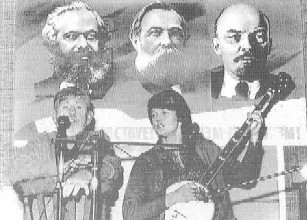
It was an unlikely team, thinks Peter Cox:
Take a communist playwright, actor, singer and songwriter and introduce
him to a young American musician and singer half his age. They fall in love.
Add an ex-submarine commander with an eccentric view of radio as Art. Send them
with the new mobile tape recorder to railway yards, onto fishing vessels, down
coal mines, in search of gypsy encampments.

Peter Cox, Set Into Song - Ewan MacColl, Charles Parker, Peggy Seeger and the Radio Ballads.
Labatie, 2008, ISBN 978-0-9551877-1-1, 298pp, £20.00.
Ewan MacColl (1915-89), the red megaphone (-> FW#6, FW#35), Peggy Seeger (*1935), a dancer on the staves (-> FW#31, FW#31, FW#33, FW#35) and Charles Parker (1919-80), an officer and a gentleman, produced a series of eight hour-long radio programmes for the BBC between 1958 and 1964, the famous "Radio Ballads".
The first one was a dramatic treatment of the story of John Axon, a train conductor awarded the George Cross posthumously for staying in the cab of a run-away goods train until it crashed. They collected 40 hours of actuality, Ewan wrote songs inspired by it, and Peggy did the orchestrations. She had to acquire a book on composing and gave herself a crash course. It was a mix of music, railwaymen's voices and sound effects. The novelty lies in the use of music and song helping to tell the story, and the lack of a spoken narration. Until then music was used only for scene setting and ilustration, and there were hardly any voices other than those of actors.
"The Ballad of John Axon" was broadcast on 2 July 1958. The BBC's response was lukewarm at best and hostile at worst, the press response was congratulatory, the railwaymen liked it, so did Axon's widow. The audience reaction was mixed,
with a sharp divide between enthusiasts and loathers, and little middle ground. For every 'Ambitious. Adventurous. Wonderfully unusual. A real break into a new art form. Unconventional, untraditional, but all completely right, nothing jarred', there was an 'I hope to calm down later ... It, by its very method, smothered and almost buried the story, the heroic story - even cheapened the iron courage of the man by putting him on ... with banjos, guitars and, worse still, calypsos.'
Why write about a series of radio programmes nearly 50 years old? Peter Cox explains: Before these programmes were made, radio and TV in Britain rarely faetured real people talking about their own lives. Woven into the stories are carefully crafted songs, written by Ewan MacColl after long study of the vocabulary and vocal rhythms of the speakers. Their words are literally 'Set into Song'.
The following series included the building of the M1, Britain's first motorway, East Coast herring fishermen, miners and mining, polio sufferers, teenagers (with no use made of the teenager's own music), professional boxing, and the travelling people. Musicians featured were Bert Lloyd (-> FW#6),
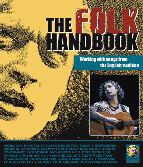
Traditional music by its very definition springs from the past. It has a history, some songs and ballads over centuries, some over mere generations. But in our time, the approach of some people attempting to update this music can be inappropriate, sometimes lacking in understanding, and failing to pay sufficient attention to the value of what we have. Certainly the tradition belongs to everyone, but we are the stewards of it for future generations, and should cherish, nurture and respect it. The conservative approach, echoed by Shirley Collins. Does she like the boldest and most ambitious effort to update traditional folk song in recent times: the Imagined Village project (-> FW#35). Simon Emmerson's brief was simple enough - to re-imagine traditional folk song for a post-industrial 21st century Britain via a series of collaborations between folk performers and artists working with such contemporary urban forms as drum'n'bass, trip-hop and rock, as well as imported styles that have become an integral part of our multicultural society, such as bhangra and reggae. The Folk Handbook is featuring essays on English folk song, folk revivals, folk music today, and working with folk songs by Martin Carthy (-> FW#36) himself, as well as folk artist portraits from FJ Child to Cecil Sharp, Alan Lomax to Ewan MacColl. The ring binder is clearly aimed to work with; it also features lyrics and tunes of 90 traditional songs collected at the turn of the 20th century: more or less folk hits such as "The Unquiet Grave" (e.g. recently recorded by -> FW#34), "Adieu, Sweet Lovely Nancy" (-> FW#28, #31), "Greenland Whale Fishery" (-> FW#20, FW#32) and "The Rambling Blade" (aka Newlyn/Newry Town -> FW#25, FW#28, FW#35, #37). Each song is given with lyrics and melody and notes on history, meaning, story of its collection and list of recordings. There is a discography, a bibliography and a web guide, plus a CD of recently recorded traditional singers. On the companion website you can find MIDI files of the songs covered, and a companion CD, "Old Wine/New Skins" (-> FW#37), which features 17 songs by contemporary artists. English Folk Dance & Song Society, The Folk Handbook - Working with Songs from the English Tradition. Backbeat, 2007, ISBN 978-0-87930-901-5, 288pp, £19.95 (incl. CD) (www.folkhandbook.com). |
It is largely assumed that the Radio Ballads were stopped for political reasons, but it was sheer cost and time. One hour was costing as much as one hour of television, as much as ten average BBC radio programmes or three typical radio features. Only in 2006 a new series was made for BBC Radio 2 by John Tams (-> FW#33).
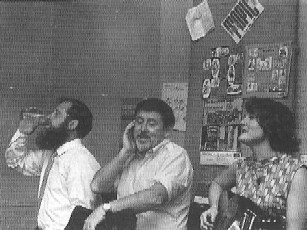
Coinciding with Peggy Seeger's UK tour and the 50th anniversary of the first broadcast was the publication of Peter Cox's Set Into Song. He describes the making of every Radio Ballad in detail, tells about the (his)tory of BBC and documentaries before the Radio Ballads, and takes a look behind the curtains. It also includes an analysis about interview techniques and songwriting. The aftermath: Parker's career inside and outside the BBC until his death in 1980; Ewan and Peggy's collaboration until his death in 1989 (including some nice additions to Ben Harker's MacColl biography (-> FW#35); Peggy's surfacing as a topical songwriter. The book's website www.setintosong.co.uk provides footnotes, a full list of sources, the complete text of the programmes and a discussion forum.
The Radio Ballad on the travelling people were Ewan and Peggy's musical masterpiece.
The travellers were among the chief carriers of the English and Scots folksong traditions,
as Hamish Henderson once said: There are many branches to a tree but the travelling
people are the roots.
The Radio Ballads featured singer
Belle Stewart,
who went on to a successful singing career afterwards.
When Ewan paid a visit to Belle, she wrote a song:
In the folk revival of the 1960s the singers, musicians and storytellers
among the surviving travellers became famous and influential as sources of the old, neglected
traditions.
'Twas on a Saturday afternoon
A wee before the sun gaed doon
That Ewan cam frae London Toon
To meet the Stewart family
When he came in we were gey shy
But we got acquainted as time gaed by
And afore he left, you could hear him cry
"You are a helluva family"

Sheila Stewart, Queen Amang the Heather - The Life of Belle Stewart. Birlinn, 2006, ISBN 978-1-84158-528-4, 194pp, £7.99. |
Belle Stewart was born in 1906 in a bow tent by the River Tay. The family's wandering days were over, and her mother got a house in Blairgowrie where the raspberry picking gave summer employment. Belle learned her first song, "The Twa Brothers", at the age of seven. She married in 1925, her husband Alec was playing pipes in lay-bys and switchbacks in the Scottish Highlands for American tourists. Their forebears were wandering tinsmiths, hounded and racially abused for centuries, until recently and probably today. Belle and Alec's daughter remembers the following incident:
When conscription came, my father and Ace [Mitchell] joined the Black Watch as pipers and were sent to Dunkirk. Pipers in these days were also stretcher-bearers; they took the wounded of the field and back to the Red Crosss camp. Their captain was a man from Blairgowrie. One day, my father was at the battlefield when the captain got wounded in the leg. There were no stretchers at this time, so my father lifted him on his shoulder and carried him back to the Red Cross camp. When they reached the camp, he laid his captain on a bed. He stared up at my father and said, Is that you, Stewart? Did you just save me from the battlefield? My father answered, Yes, I did. - Well, if I had known it was a tink that saved me, I would've told you to leave me to die.
In 1947 Belle wrote her famous song, "The Berry Fields o Blair," in time to come "Bonnie Hoose of Airlie" and "Dowie Dens of Yarrow". The latter has been recorded by Dick Gaughan for example (-> FW#23). Soon every singer worth his salt was singing into microphones, recording Belle's tunes. Alec and Belle and their two daughters Sheila and Cathie became internationally famous star performers, known as the Stewarts of Blair.
In Queen Amang the Heather Sheila Stewart tells the story of her mother in a series of anecdotes,

Sheila Douglas, Last of the Tinsmiths - The Life of Willie MacPhee. Birlinn, 2006, ISBN 1-84158-511-4, 195pp, £7.99. |
Belle Stewart died in 1997. Sheila Douglas sighed: When she died we all felt it was the end of an era and that we had lost a mother figure in Belle.
Sheila Douglas is fond of another traveller: Willie MacPhee. Willie was the first cousin of Alec Stewart and they went together up the glens piping for years. They both composed a tune betwen them dedicated to their wives, "The Belles of Loch Lochy." Willie's mother too featured in the Radio Ballad on the travellers.
Willie could play anything he was asked to play by the folk who alighted from the tourist coaches, a real pipe tune from his vast repertoire or some ditty like "Yankee Doodle Dandy" or the latest pop song. Piping was his great passion, without ever becoming involved in the commercial scene. He attended many clubs and festivals, but shunned the limelight, never competed, and sang and told stories and played the pipes in ceilidhs and sessions. He was just doing what all his forebears had done round the fireside.
He was a tradition bearer of the travelling people, remarks Sheila, who never lived in a house and did not read or write; a poor man all his days but incredibly rich in cultural terms. The Last of the Tinsmiths is an account of the life and accomplishments of Willie MacPhee (1910-2001). It is no biography in chronological order, but explores different aspects: the tinsmith, the storyteller, the piper. Including tales, songs and tunes, and a glossary of Perthshire cant.
He gaed wi his pipes ta the Heilans an Islands
Tae play for his livin by lochside an ben
An he ne'er tuik a hoose but aye bade in a trailer
Whaur he fun aa the freedom nae scaldie can ken
And that's the end of my story, Willie MacPhee used to say,
I don't know if that's a lie or the truth, but that's the way I heard it!
|
To the German FolkWorld |
© The Mollis - Editors of FolkWorld; Published 11/2008
All material published in FolkWorld is © The Author via FolkWorld. Storage for private use is allowed and welcome. Reviews and extracts of up to 200 words may be freely quoted and reproduced, if source and author are acknowledged. For any other reproduction please ask the Editors for permission. Although any external links from FolkWorld are chosen with greatest care, FolkWorld and its editors do not take any responsibility for the content of the linked external websites.
